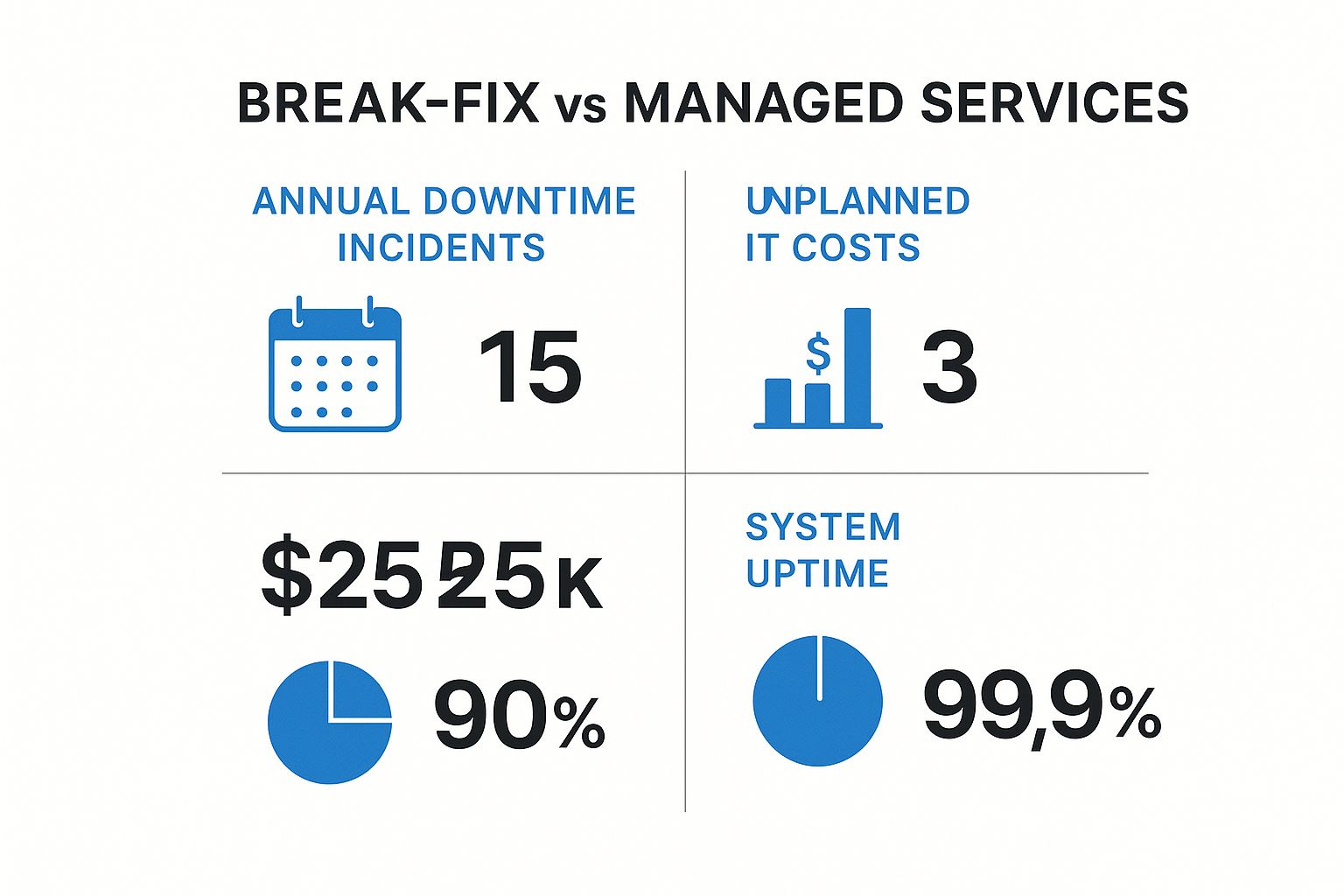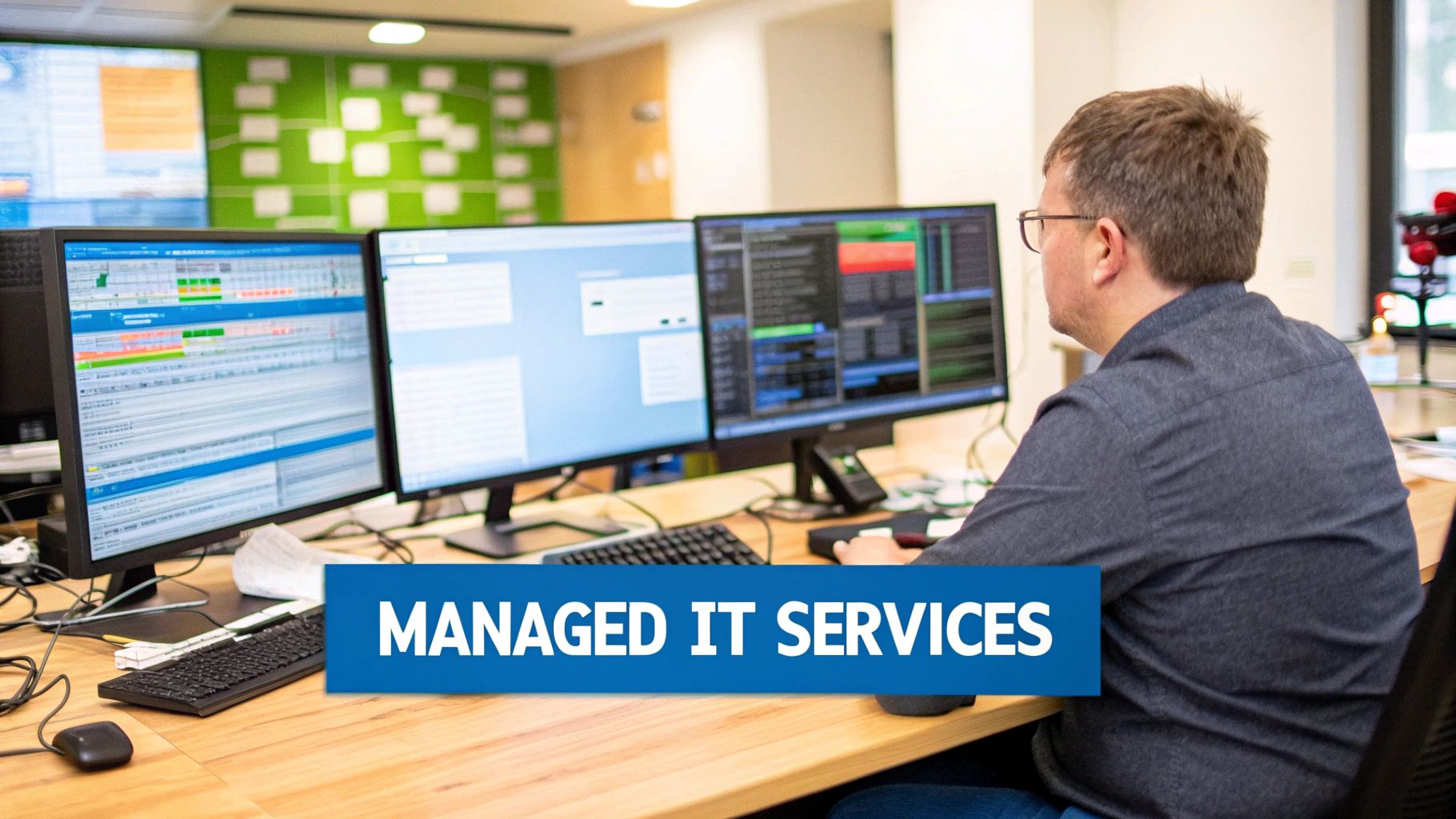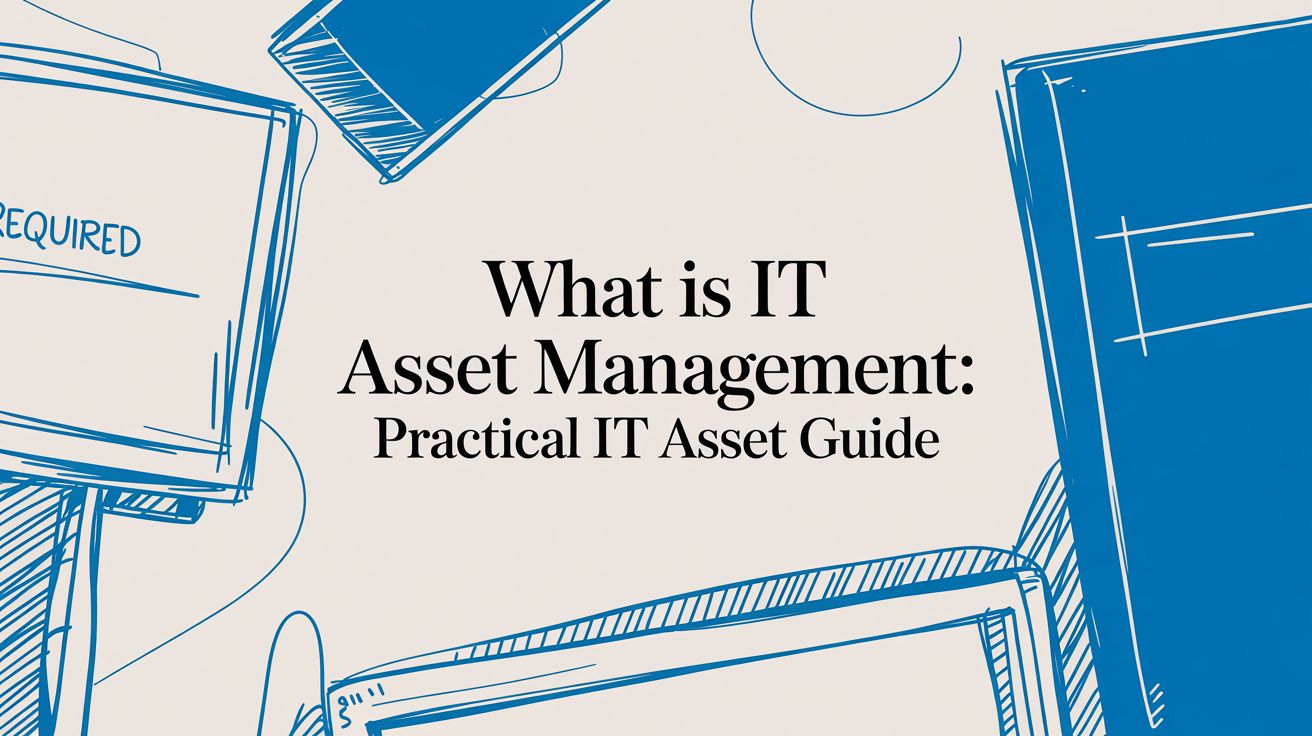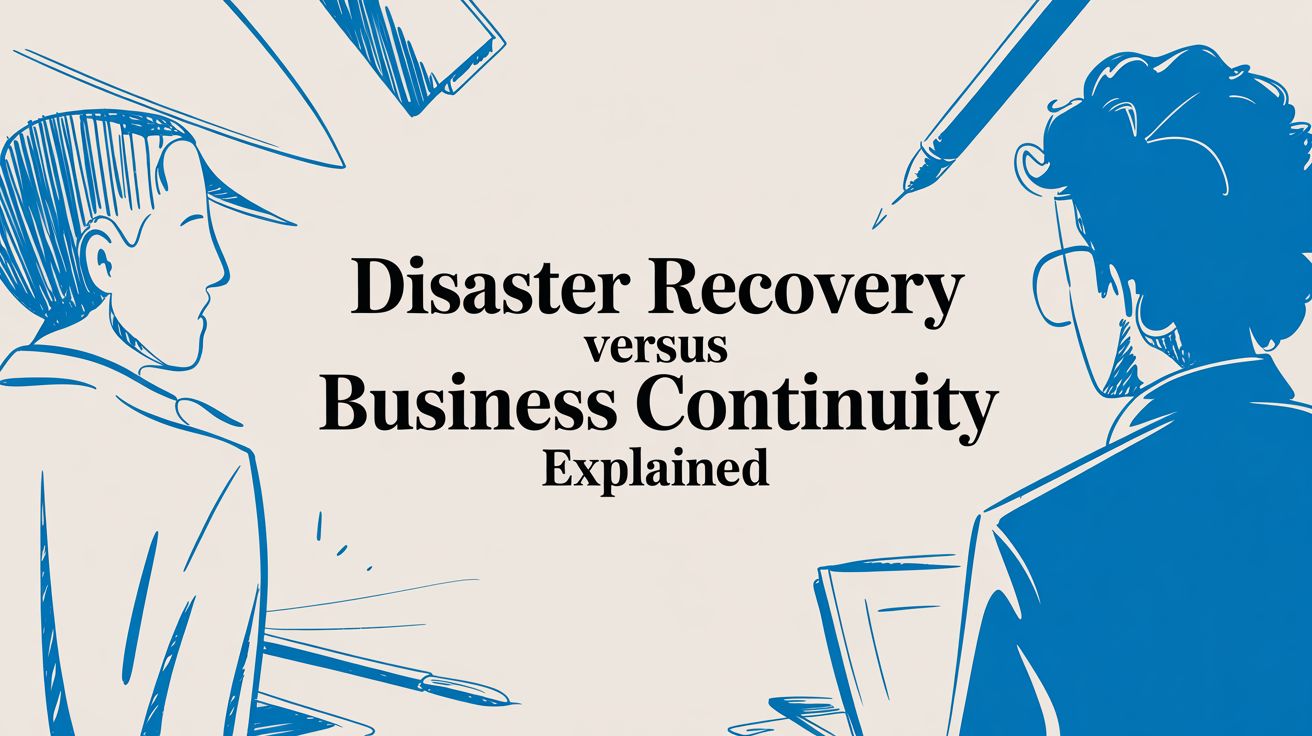What Do Managed Service providers Do? A Guide for SMBs
So, what do managed service providers do? Think of an MSP as your dedicated, proactive technology partner. For a predictable monthly fee, they take full responsibility for your IT infrastructure, shifting your business away from reactively fixing problems and into a model that prevents them from ever starting.
Their goal is simple: to ensure your technology is a powerful asset that drives growth, not a constant source of frustration and unexpected costs.
Your Proactive IT Partner Explained
Let's start with the old way of doing things, often called the "break-fix" model. This is like having a plumber on speed dial. You only call them after a pipe has burst and your office is flooding. By then, the damage is done. You're left dealing with costly downtime, frustrated employees, and a hefty, unexpected bill to fix a problem that has already brought your business to a standstill.
A Managed Service Provider (MSP) flips that entire model on its head. They are more like a facilities manager for your digital infrastructure. They aren't waiting for a crisis. Instead, they’re constantly working in the background—monitoring your network for threats, applying security patches, and optimizing performance to stop issues before they impact your operations.
This fundamental shift from a reactive scramble to proactive management is the core value of managed services.
The Old Way vs. The Modern Approach
The traditional break-fix model had a serious flaw: your IT support provider only made money when your technology failed. This created a built-in conflict of interest where your pain was literally their gain.
The modern MSP model aligns their success directly with yours. Since they operate on a flat-fee subscription, it's in their best interest to keep your systems running flawlessly and securely. Fewer problems for you mean more efficiency and profitability for them. This creates a true partnership where your technology is strategically managed to support your business goals, not just patched up when it fails.
Here’s a quick breakdown of how these two approaches stack up.
Break-Fix IT vs. Managed Services: A Quick Comparison
As you can see, the proactive MSP model is designed to give you peace of mind and predictable results, turning your IT from a chaotic cost center into a reliable strategic advantage.
This infographic clearly illustrates how each approach impacts your bottom line and overall operations.

The data speaks for itself. The managed services model dramatically cuts down on expensive disruptions and boosts operational reliability. This is precisely why so many SMBs are leaving hourly IT consultants behind and forming strategic partnerships that deliver real value. Many of these partnerships even include high-level guidance, similar to what you’d get from having virtual CIO services in Dallas, TX.
The market growth reflects this shift. Valued at roughly USD 441.1 billion in 2025, the managed services market is expected to rocket past USD 1.3 trillion by 2035. This massive growth is driven by companies seeking predictable costs, better cybersecurity, and access to specialized expertise they can't afford to hire in-house. Learn more about managed services market growth.
Exploring Core Managed IT Services

It’s one thing to talk about a proactive approach, but what does an MSP actually do day-to-day? Their work is delivered through a set of foundational services that manage, secure, and support every part of your technology stack. Think of these core offerings as the engine that keeps your business humming along reliably.
Let's use a real-world example. Picture a mid-sized accounting firm in Dallas heading into tax season. This is their make-or-break time of year. For them, downtime isn't a minor annoyance—it's a direct hit to their revenue and client trust. This is exactly where an MSP’s core services prove their worth, working together to keep that firm running flawlessly.
Proactive Monitoring and Maintenance
Long before anyone on your team even suspects a problem, a good MSP is already on the case. They use sophisticated remote monitoring and management (RMM) tools to keep a constant, automated eye on your entire IT environment. It’s like having a digital security guard patrolling your network 24/7, checking every server, workstation, and network device for signs of trouble.
This round-the-clock watch allows the MSP to catch subtle issues—like a server's hard drive getting dangerously full or an unusual spike in network traffic—and fix them before they turn into show-stopping disasters. For our Dallas accountants, this means a failing server part gets spotted and replaced overnight, completely avoiding a system crash during the busiest week of the year.
24/7 Helpdesk and Remote Support
When technology questions pop up—and they always do—your employees need quick, expert help to get back on track. A central helpdesk is a non-negotiable part of any managed service, acting as the single point of contact for any and all IT needs.
Instead of your staff wasting billable hours trying to fix their own computer issues, they can get immediate support from a qualified technician.
Key Takeaway: An effective helpdesk is less about fixing broken things and more about protecting productivity. Fast resolutions mean your team spends less time fighting with their tools and more time driving business value.
Modern remote support tools are a game-changer. They let technicians securely access an employee's computer (with permission, of course) to diagnose and resolve issues directly, as if they were sitting at the desk. Our accounting firm’s team can get a software bug squashed in minutes, not hours, keeping their critical workflows moving. To see this in action, you can learn more about what professional IT helpdesk support in Dallas, TX looks like.
Network, Infrastructure, and Endpoint Management
Your network is the central nervous system of your business. It connects everything from your servers and computers to printers and cloud applications. An MSP takes full ownership of managing this complex ecosystem to ensure it’s always fast, dependable, and secure.
This is a multi-layered responsibility that includes:
- Network Management: Optimizing Wi-Fi performance, managing firewalls to keep threats out, and ensuring all your devices communicate without bottlenecks.
- Infrastructure Support: Maintaining the physical and virtual hardware—servers, switches, and routers—that underpins your entire operation to maximize uptime.
- Endpoint Management: Securing every device that connects to your network, from laptops and desktops to tablets and smartphones. This means deploying endpoint protection, installing critical security patches, and enforcing company-wide security policies on every machine.
For the accounting firm, this all-encompassing management guarantees that sensitive client data stays protected, the network can handle the intense traffic of tax season, and every employee’s computer is secure and compliant.
Building Your Cybersecurity Defenses
Think of a good Managed Service Provider as your dedicated security operations team. In a world full of digital threats, they don't just install antivirus software and call it a day. Instead, they build a fortress around your business with multiple layers of defense. It’s like securing a castle; you wouldn't just rely on a single gate. You'd want a deep moat (firewall), high walls (endpoint protection), and guards on patrol (continuous monitoring) to keep intruders out.
This layered security model is essential because cybercriminals are always probing for the path of least resistance. A truly strong defense has overlapping security controls, so if one layer is bypassed, another is right there to stop the attack. This proactive mindset is at the heart of how MSPs protect their clients.

Key Technologies in a Modern Defense Strategy
An MSP comes armed with an arsenal of sophisticated tools to create these protective layers. Each technology has a specific job, and they all work together to form a cohesive security shield.
- Managed Firewalls: This is your network's front door. A managed firewall acts as a digital gatekeeper, inspecting all traffic entering and leaving your network. It's configured with rules to block malicious connections before they can reach your computers or servers.
- Endpoint Detection and Response (EDR): Traditional antivirus software was designed to stop threats it already knew about. EDR is the next evolution. It actively hunts for suspicious behavior on every device. If it spots activity associated with ransomware or malware, it can automatically isolate that machine to prevent the threat from spreading.
- Vulnerability Assessments: MSPs regularly scan your entire system for weaknesses. They're looking for things like unpatched software or misconfigured security settings—the digital cracks that hackers love to exploit. By finding and fixing these gaps, they shut down potential entry points.
The Human Element: Security Awareness Training
Technology is a huge part of the equation, but your employees are your true front line. The number one cause of security breaches is still the simple phishing email, where an attacker impersonates a trusted contact to trick someone into clicking a dangerous link. This is precisely why Security Awareness Training is one of the most critical services an MSP offers.
A good MSP will run simulated phishing attacks to see how your team responds. These are safe, controlled tests designed to help employees spot the red flags in a real-world scenario. The goal isn't to play "gotcha," but to build a strong security-first culture where everyone on the team becomes a human firewall. For example, staying sharp is key for understanding the rising threat of infostealer malware, which almost always starts with a clever email.
Real-World Example: A logistics company in Memphis had a recurring problem with staff clicking on suspicious links. Their MSP rolled out quarterly phishing simulations paired with short, focused training modules. In just six months, the company saw a 90% drop in its click-rate on dangerous links, which helped them dodge a ransomware attack that could have shut down their entire supply chain.
This kind of proactive training is a cornerstone of modern IT security. If you're interested in going deeper, a great next step is to learn how to implement Zero Trust security—a model built on the principle of "never trust, always verify."
Keeping Your Business Running No Matter What
https://www.youtube.com/embed/OmASCUJEVy8
Beyond day-to-day IT support and cybersecurity, what happens when a real disaster strikes? A catastrophic server failure, a ransomware attack that encrypts all your files, or a natural disaster that takes your office offline. These are the moments that can bring a business to its knees.
This is where a good MSP shifts from being a manager to a protector, implementing a business continuity plan that ensures your company can weather the storm and get back on its feet quickly.
Many businesses think having a simple data backup is enough. While it's a critical first step, just having copies of your files is only one piece of a much bigger puzzle. True business continuity isn’t just about restoring data—it’s about having a complete, tested plan to keep your entire business operational. A skilled MSP builds and manages that plan for you.
From Simple Backups to a Full Recovery Plan
A solid disaster recovery strategy is a layered approach built with smart technology and well-defined processes, all managed by your MSP. The goal is to keep downtime and data loss to an absolute minimum, no matter what goes wrong. This goes way beyond plugging in an external hard drive once a week.
An MSP-driven recovery plan typically includes these key ingredients:
- Automated Cloud Backups: Your data is backed up automatically and securely to multiple off-site data centers. This protects it from any local event at your physical office, like a fire, flood, or theft.
- Failover Systems: If a primary server fails, a standby system can kick in almost instantly. This means your team can keep working with minimal interruption.
- Rigorous Testing: A plan is just a theory until it's tested. MSPs regularly run drills on the entire recovery process to find weak spots and fix them before a crisis hits.
Getting a handle on how to prepare for these kinds of disruptions is essential for any business. You can get a deeper understanding by exploring various business continuity and disaster recovery strategies.
Client Story: Surviving a Server Room Flood
A property management company in Texas walked into a nightmare: a burst pipe had completely flooded their server room, destroying all their core hardware. But because their MSP had already implemented a cloud-based disaster recovery plan, what could have been a company-ending event was just a manageable problem.In less than an hour, the MSP activated the cloud failover system. The entire company was back online, working from the cloud as if nothing had happened. They avoided the massive data loss and financial fallout that would have otherwise crippled their business.
This story drives home the difference between having a backup and having a true recovery plan. The MSP didn't just restore files; they kept the entire business running.
At PWR Technologies, we build these kinds of resilient systems every day. You can learn more about our comprehensive approach to business continuity in Dallas, TX.
Using Cloud Solutions to Gain a Competitive Edge
 for response and resolution times?" This tells you exactly what to expect when issues arise and holds them accountable for performance.
- Strategic Alignment: "How will you align our technology roadmap with our long-term business goals?" This separates reactive problem-fixers from proactive partners who think about your future growth.
- Crisis Management: "Can you describe a time you helped a client recover from a major IT crisis like a ransomware attack?" Their answer will reveal their real-world problem-solving skills under pressure.
The United States is the biggest market for managed services, with an estimated 40,000 to 45,000 MSPs all competing for your attention. Companies are increasingly hiring them to reduce operational headaches and gain access to enterprise-grade technology. In fact, the market is projected to hit $281.87 billion by 2034.
All this competition makes doing your homework absolutely essential. You can read more about the growth of the managed services market to understand the trend. At the end of the day, you’re looking for a provider who understands your local market, whether that's Dallas or Memphis, and is genuinely invested in seeing your business succeed.
Your Top Questions About Managed Services, Answered
Thinking about bringing a managed service provider on board? It's a big decision, and you probably have a few questions. We get it. Here are some straightforward answers to the questions we hear most often from business leaders in Dallas and Memphis.
Are Managed IT Services Just for Big Corporations?
That’s a common misconception. In reality, small and mid-sized businesses (SMBs) often see the biggest return from partnering with an MSP.
You get access to enterprise-level security tools, a deep bench of IT specialists, and proactive 24/7 support—all for a predictable monthly fee. Building an internal team with that level of expertise would be cost-prohibitive for most SMBs.
How Do You Figure Out the Price for Managed Services?
Most MSPs structure their pricing as a simple subscription. It's usually based on either the number of employees on your team (per user) or the number of computers and servers being managed (per device).
This model turns your IT costs into a predictable operational expense (OpEx), which makes budgeting much easier. The final price depends on the specific services you need, such as advanced cybersecurity, cloud infrastructure management, or industry compliance support.
What's the Difference Between Co-Managed and Fully Managed IT?
This is a great question, as it highlights the flexibility of MSP partnerships.
Fully managed IT is the all-in-one solution. The MSP acts as your complete IT department, handling everything from daily helpdesk tickets to long-term technology strategy. It's the perfect solution if you don't have any in-house IT staff.
Co-managed IT, on the other hand, is a partnership model. Here, the MSP works alongside your existing IT person or team. We can supplement their skills with specialized expertise in areas like cybersecurity, provide 24/7 monitoring to free up their time, or take on routine maintenance so your team can focus on strategic, business-driving projects.
Ready to turn your technology into a reliable asset? PWR Technologies provides proactive IT support that keeps your Dallas or Memphis business secure, productive, and focused on growth. Learn more about our managed services.




